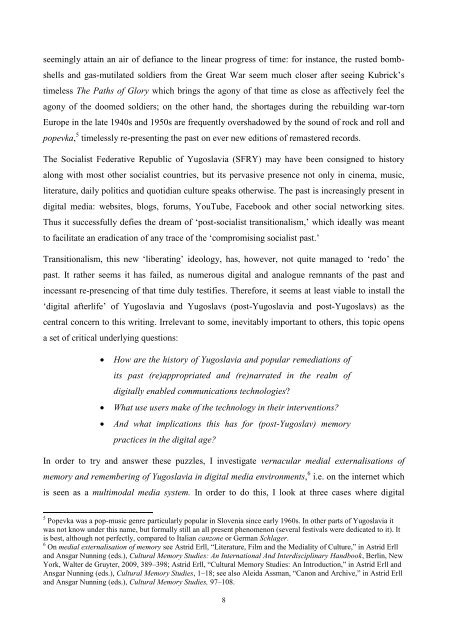UNIVERSITY OF NOVA GORICA GRADUATE SCHOOL ...
UNIVERSITY OF NOVA GORICA GRADUATE SCHOOL ...
UNIVERSITY OF NOVA GORICA GRADUATE SCHOOL ...
You also want an ePaper? Increase the reach of your titles
YUMPU automatically turns print PDFs into web optimized ePapers that Google loves.
seemingly attain an air of defiance to the linear progress of time: for instance, the rusted bombshells<br />
and gas-mutilated soldiers from the Great War seem much closer after seeing Kubrick‘s<br />
timeless The Paths of Glory which brings the agony of that time as close as affectively feel the<br />
agony of the doomed soldiers; on the other hand, the shortages during the rebuilding war-torn<br />
Europe in the late 1940s and 1950s are frequently overshadowed by the sound of rock and roll and<br />
popevka, 5 timelessly re-presenting the past on ever new editions of remastered records.<br />
The Socialist Federative Republic of Yugoslavia (SFRY) may have been consigned to history<br />
along with most other socialist countries, but its pervasive presence not only in cinema, music,<br />
literature, daily politics and quotidian culture speaks otherwise. The past is increasingly present in<br />
digital media: websites, blogs, forums, YouTube, Facebook and other social networking sites.<br />
Thus it successfully defies the dream of ‗post-socialist transitionalism,‘ which ideally was meant<br />
to facilitate an eradication of any trace of the ‗compromising socialist past.‘<br />
Transitionalism, this new ‗liberating‘ ideology, has, however, not quite managed to ‗redo‘ the<br />
past. It rather seems it has failed, as numerous digital and analogue remnants of the past and<br />
incessant re-presencing of that time duly testifies. Therefore, it seems at least viable to install the<br />
‗digital afterlife‘ of Yugoslavia and Yugoslavs (post-Yugoslavia and post-Yugoslavs) as the<br />
central concern to this writing. Irrelevant to some, inevitably important to others, this topic opens<br />
a set of critical underlying questions:<br />
<br />
<br />
<br />
How are the history of Yugoslavia and popular remediations of<br />
its past (re)appropriated and (re)narrated in the realm of<br />
digitally enabled communications technologies?<br />
What use users make of the technology in their interventions?<br />
And what implications this has for (post-Yugoslav) memory<br />
practices in the digital age?<br />
In order to try and answer these puzzles, I investigate vernacular medial externalisations of<br />
memory and remembering of Yugoslavia in digital media environments, 6 i.e. on the internet which<br />
is seen as a multimodal media system. In order to do this, I look at three cases where digital<br />
5 Popevka was a pop-music genre particularly popular in Slovenia since early 1960s. In other parts of Yugoslavia it<br />
was not know under this name, but formally still an all present phenomenon (several festivals were dedicated to it). It<br />
is best, although not perfectly, compared to Italian canzone or German Schlager.<br />
6 On medial externalisation of memory see Astrid Erll, ―Literature, Film and the Mediality of Culture,‖ in Astrid Erll<br />
and Ansgar Nunning (eds.), Cultural Memory Studies: An International And Interdisciplinary Handbook, Berlin, New<br />
York, Walter de Gruyter, 2009, 389–398; Astrid Erll, ―Cultural Memory Studies: An Introduction,‖ in Astrid Erll and<br />
Ansgar Nunning (eds.), Cultural Memory Studies, 1–18; see also Aleida Assman, ―Canon and Archive,‖ in Astrid Erll<br />
and Ansgar Nunning (eds.), Cultural Memory Studies, 97–108.<br />
8

















